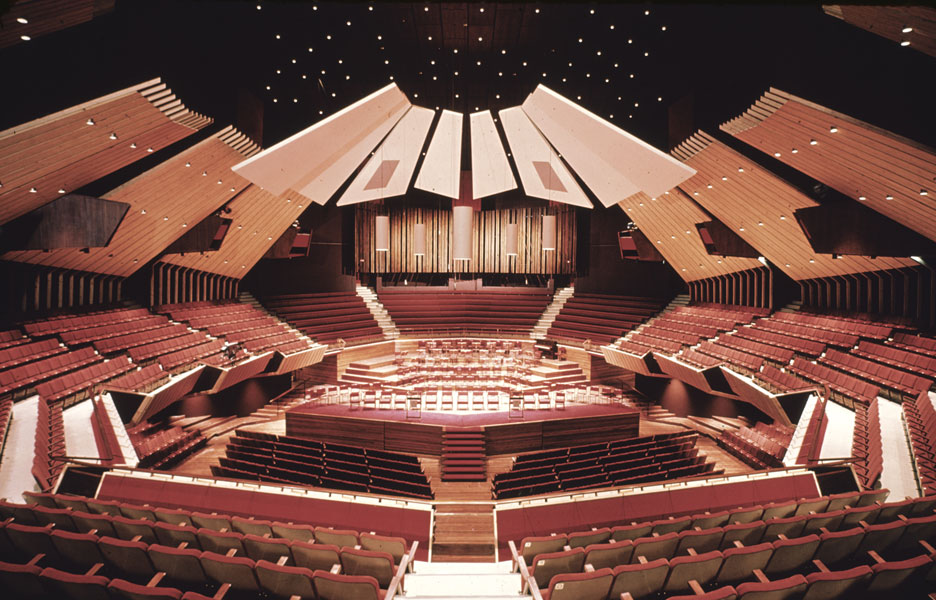I’m heartened that the newly opened Philharmonie de Paris shows that radical acoustic design is still possible in auditoria. The Philharmonie isn’t a facsimile of an old venerated hall, but an auditorium of its time, one that could only be built now, exploiting modern acoustic engineering.
“it’s as if the French Republic had declared an end to the rule of the Cartesian straight line in favour of asymmetric natural curved forms”

In terms of acoustic ancestry, there are two halls that jump out to me, both of which were radical concert hall designs in their day. First is Christchurch Town Hall. Opened in 1972, it was designed by Harold Marshall, whose company is also one of those behind the new Paris hall. Like the Philharmonie de Paris, Christchurch has reflecting surfaces close to the audience to create early arriving reflections, with a much large volume behind to create that reverberance that is so important for a concert hall. Early reflections that reach a listener from the side are crucial for creating a sense of intimacy, without these an orchestra sounds distant. Reverberance is particularly noticeable when the orchestra finished a dramatic piece, and the notes linger in the hall for a couple of seconds.

The second ancestor for me is the Berlin Philhamonie, a pioneering hall from the 1960s that showed that audiences could be split up into sections, with the walls surrounding the blocks of seating being used to provide beneficial early reflections. The Berlin design also gets more of the audience closer to the stage, which also helps the audience to feel more engaged with the performance.
While fashion dictates that the Philharmonie de Paris is made from sweeping curves, the influences of halls such as Christchurch and Berlin Philharmonie can be seen. The audience are in blocks, and there is a large reverberant volume up above the ceiling reflectors and behind the balconies. Modern computer modelling (backed up by more old fashioned scale modelling), enabled the shaping of the complex reflectors, walls and balcony fronts in the Philharmonie de Paris. Every surface is carefully shaped to provide reflections to enhance the acoustic for the audience.
I can’t wait to visit the hall in October at the IOA’s Auditorium Acoustics Conference. Not only to hear the hall, but to hear the designers explain more about the acoustics. Have you been lucky enough to hear the hall?
Follow me
0 responses to “The Shape of the Philharmonie de Paris”
Thank you Trevor! Quite correct: the Christchurch TH first alerted me to the possibility of un compromised multiple use spaces. Berlin demonstrates the importance of a great architectural/acoustical idea. See you in October!
What an honour to have a comment from you! 🙂
Trevor, is there “call for paper” for the Oktober meeting?
Sorry deadline was a couple of weeks ago. But if you want to drop me an email with an abstract I’ll see what I can do (no promises). But I would need it this weekend.
Looking at amazing acoustical performance and making assumptions, that the sound inside is adequate to view impression, suddenly I ask myself: what are base features of difference between hearing “natural sound” in such a halls and, for instance, earphones?
I’ve seen many words about modern electroacoustical methods to control reverberation and early reflections field. I know Yamaha, Constellation and some others, who mean, that such a system is capable to repair any poor acoustics (at condition, that RT60 no more than 1.0 s). What are these advantages or not? Where is the border between “pleasant – unpleasant”?
ups, I missed your message, actually I would like to write about the acoustics of our newly restorated West Hall and East Hall at my campus ITB (Institut Teknologi Bandung), which were built on 1920. The paper would be the detailed version of the one I wrote in my blog: https://jokosarwono.wordpress.com/2014/02/10/akustik-aula-barat-itb-pasca-restorasi-2/ . Unfortunately I missed the deadline. Thanks Trevor
[…] in Vienna. Others have been arguing that a new design is needed, something bold like the Philharmonie de Paris with its futuristic curves and radical flying balconies and clouds. So what is the best shape for […]